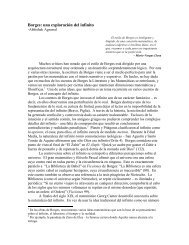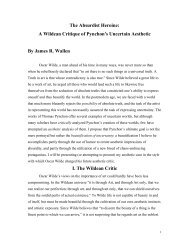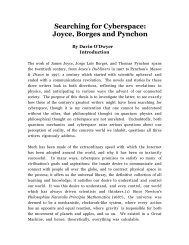And A Very Good Time It Was: A Short Life of ... - The Modern Word
And A Very Good Time It Was: A Short Life of ... - The Modern Word
And A Very Good Time It Was: A Short Life of ... - The Modern Word
You also want an ePaper? Increase the reach of your titles
YUMPU automatically turns print PDFs into web optimized ePapers that Google loves.
life. 29<br />
He sent the play to Archer for criticism, and what little is known <strong>of</strong> the lost play today comes<br />
in part from Archer’s letter. One criticism, that he first employs a large canvas only, in the end, to<br />
focus on a few people, became the virtues <strong>of</strong> “<strong>The</strong> Dead,” Ulysses, and Finnegans Wake. 30<br />
Perhaps Archer’s finest comment echoes all would-be fans <strong>of</strong> Joyce: “At present I am interested<br />
and a good deal impressed, but also, I must confess, a good deal bewildered.” 31<br />
Between 1900 and 1903 Joyce began scribbling the prose experiments he called<br />
“Epiphanies,” by which he meant<br />
the sudden ‘revelation <strong>of</strong> the whatness <strong>of</strong> a thing,’ the moment in which ‘the soul<br />
<strong>of</strong> the commonest object ... seems to us radiant ... a sudden spiritual<br />
manifestation [either] in the vulgarity <strong>of</strong> speech or <strong>of</strong> gesture or in a memorable<br />
phrase <strong>of</strong> the mind itself.’ 32<br />
Joyce’s aesthetic, given in full in chapter 5 <strong>of</strong> Portrait, was the result <strong>of</strong> many years <strong>of</strong><br />
thinking. Perhaps first stumbled upon when reading Ibsen, the double-realization was that art<br />
need not be moral, and that the lives <strong>of</strong> supposedly “ordinary” people were as worthy subjects for<br />
art as kings.<br />
By declaring that art need not be moral, Joyce did not mean to favor the creation <strong>of</strong> immoral<br />
art; rather he rejected didactic judgments <strong>of</strong> any kind. Art should not tell us how to live our lives<br />
but, by understanding and experiencing genuine works <strong>of</strong> art, our own lives are vitalized.<br />
He felt proper art, rather than being kinetic, was static: it didn’t impel you to do anything.<br />
Rather you stand away and, instead <strong>of</strong> judging a work, you simply behold it. Here he used<br />
Aquinas’ three terms when apprehending beauty: you apprehend a work’s integritas, its<br />
wholeness as one thing. Next, you understand the relationship <strong>of</strong> each <strong>of</strong> the parts to one another,<br />
each <strong>of</strong> the parts to the whole, and the whole to each <strong>of</strong> its parts: its consonantia. Finally there is<br />
the breakthrough, the claritas, which Stephen Dedalus calls<br />
the artistic discovery and representation <strong>of</strong> the divine purpose in anything ... You<br />
see that it is that thing which it is and no other thing. <strong>The</strong> radiance <strong>of</strong> which he<br />
speaks is the scholastic quidditas, or whatness <strong>of</strong> a thing. 33<br />
To help realize this, Joyce rejected the literal teachings <strong>of</strong> Catholicism but nevertheless<br />
ransacked and made its symbols relevant to his secular art. He once remarked to Stanislaus,<br />
Don’t you think there is a certain resemblance between the mystery <strong>of</strong> the Mass<br />
and what I am trying to do? I mean that I am trying ... to give people some kind<br />
<strong>of</strong> intellectual pleasure or spiritual enjoyment by converting the bread <strong>of</strong><br />
everyday life into something that has a permanent artistic life <strong>of</strong> its own ... for<br />
their mental, moral, and spiritual uplift. 34<br />
<strong>And</strong> on another occasion:<br />
Do you see that man who has just skipped out <strong>of</strong> the way <strong>of</strong> that tram? Consider,<br />
if he had been run over, how significant every act <strong>of</strong> his would at once become. I<br />
don’t mean for the police inspector. I mean for anybody who knew him. <strong>And</strong> his<br />
thoughts, for anybody that could know them. <strong>It</strong> is my idea <strong>of</strong> the significance <strong>of</strong><br />
trivial things that I want to give the two or three unfortunate wretches who may<br />
eventually read me. 35<br />
With help from Aristotle’s Poetics, he determined the proper nature <strong>of</strong> tragedy and comedy<br />
(the latter which he came to prefer for his work), and distinguished three forms art can take on:<br />
lyrical, epic, and dramatic. In the lyric, being “the simplest verbal vesture <strong>of</strong> an instant <strong>of</strong><br />
emotion,” the author and subject are one, and the experience is entirely personal. In the epic, the<br />
events described are <strong>of</strong> equal distance from the author and from others, but the author is still<br />
hovering there waiting to comment (this is the form most novels have always taken). But in the





